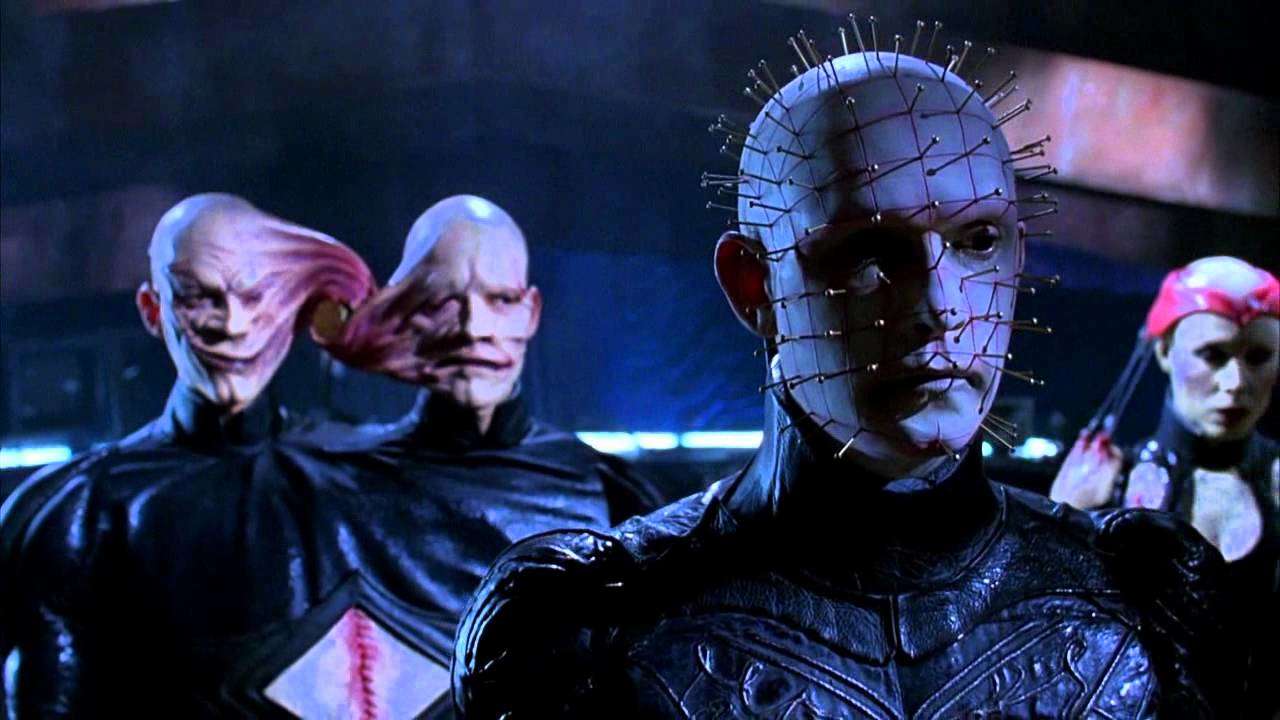Create a free profile to get unlimited access to exclusive videos, sweepstakes, and more!
Why 'Bloodline' is the most ambitious entry in the Hellraiser franchise

While the fourth entry in the Hellraiser series conceived by Clive Barker may have been the shoot from hell, killed the franchise's big-screen ambitions, and had the unwanted distinction of being disowned by both its original director and his replacement, no one can deny its ambition. As a curious mix of period drama, science fiction, and slasher horror that journeys from 18th-century French aristocracy to distant-future deep space, there's a lot happening. Cloud Atlas has nothing on Pinhead and Co.
Celebrating its 25th anniversary this month (March 8), Hellraiser: Bloodline is essentially an anthology that interlinks three generations of tortured creative minds. There's Philippe Lemarchand (Bruce Ramsay), a toymaker in 1796 Paris who unwittingly opens a portal to hell through his proudest creation, a puzzle box named the Lament Configuration. Then there's his descendant John Merchant (also Ramsay), a modern-day New York architect who's been compelled to build a skyscraper — seen at the end of predecessor Hellraiser III: Hell on Earth — that replicates the box's elaborate design and has similar demon-beckoning capabilities. And even further down the line of ancestry, there's Paul Merchant (a very busy Ramsay), a space station engineer in the year 2127 determined to shut that damned gateway once and for all.
More importantly, Bloodline explains the ultimate fate of the character whose leather-clad, ashen-faced, geometrically-spiked appearance scarred every kid of the VHS rental era for life. Yes, although he's entirely absent from the film's first third, Pinhead (Doug Bradley) still steals the show, whether he's pontificating about the "beauty of suffering," or literally ripping the face off an expendable crewman.
Pinhead also benefits from having others on his level to spark against: the Princess of Hell first summoned from the dark side by libertine Duc de L'Isle (Mickey Cottrell) and his back-stabbing assistant Jacques (a wonderfully hammy Adam Scott making his film debut in an ill-fitting powdered wig). With a look inspired by Sister Act, believe it or not, the vampish Angelique (the poorly-dubbed Valentina Vargas) considers seduction to be a more powerful weapon than torture, which is not a viewpoint shared by her fellow Satanic sadomasochist, obviously. The pair's contrasting approaches to raising hell result in some entertaining passive-aggressiveness ("You are no different from that beast who sucks the bones you throw to it") until Pinhead finally asserts full control.
The odd couple's relationship was written as even more antagonistic in Paul Atkins' original screenplay. Studio Miramax, however, reportedly wasn't comfortable with its violent undertones and, certainly not for the only time, demanded change. In fact, the 85-minute edit of Bloodline that hit cinemas in March 1996 differs wildly from the film that Atkins, Barker, and first-time director Kevin Yagher intended to make.
Several characters are sidelined or removed entirely. Pinhead is introduced much earlier on, disregarding Barker's notion that "less is more" when it comes to the ghoulish Hell Priest. And instead of Paul sacrificing himself to end the bloodline that was cursed by his toymaking forefather, the spaceman gets to fly back to Earth, leaving all the Cenobites to be vaporized by the perpetual light of the Elysium Configuration. Pinhead's closing line of "I cannot die, I live forever," still proved prophetic, though — he'd return for 2000's Inferno and five other sequels of differing quality, while he's also gracing the forthcoming TV reboot.
Primarily a special effects supervisor, a reluctant Yagher had apparently only agreed to direct due to his enthusiasm for Atkins' script. Little wonder, therefore, that he insisted on being credited as Alan Smithee — that pseudonym famously adopted by filmmakers who don't want their resume tarnished. Joe Chappelle, the man tasked with reshooting several hastily rewritten scenes just as he did on Halloween 5: The Curse of Michael Myers, refused any official acknowledgment, as well.
Miramax's interference perhaps explains why Bloodline's time-shifting plotline is largely incoherent (Atkins later described it as "an abortion… or at least some hybrid child born of three parents at war"). Yet if you can ignore the rules of Barker's universe, which appear to change from scene to scene and the nonsensical character motivations, Hellraiser IV's audaciousness provides a fun ride, particularly during the third sci-fi chapter.
Although sending a franchise into the void above typically spells creative desperation (see Jason X, Critters 4, and the nadir of the niche subgenre, Leprechaun 4: In Space), Pinhead and his grotesque gang actually thrive aboard the space station dubbed The Minos. It's here where the leader delivers his most grandiose speech, a damning — if strangely poetic — indictment of Planet Earth that berates how "there are more humans alive today than in all of its pitiful history."
It's also where the kill count quickly climbs up to the double-figure mark as the Cenobites go on the attack, and in inventive fashion, too. Take how Angelique uses some crafty mirror magic to decapitate one poor soldier, for example. Or how the two twin security guards absorb another unsuspecting victim more than two centuries after they were stretched and squished together to become horrifically conjoined themselves.
And while most of the effects have inevitably dated, the snarling animatronic monster known as The Chatterer Beast still has the capacity to haunt your nightmares. Yagher, whose past credits include the Chucky doll and Freddy Krueger's iconic, burned-skin makeup, largely decided to give the day job a rest. But thankfully, he couldn't resist working with Hellraiser journeyman Gary J. Tunnicliffe on a creation described as part-human car accident victim, part-dog remains.
Of course, Bloodline proved to be something of an ambitious failure. It took just $9 million at the box office, ensuring that Pinhead was banished to the straight-to-DVD market for the rest of eternity. Having already shown signs of franchise fatigue before getting involved ("It's a mythology which really should have laid down and died a long time ago"), Barker gave the following six-and-counting sequels a wide berth. Yagher, meanwhile, was left so disillusioned by the experience that he hasn't taken the director's chair since.
Still, considering its fraught conception — we've not even mentioned the crew strikes, flooding, and an outbreak of chickenpox that also disrupted shooting — Hellraiser: Bloodline should be applauded just for making the finishing line. Had the original team been allowed to execute their vision, it may well have had the story to match its impressive scope, too.


























